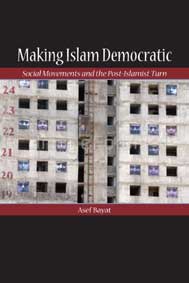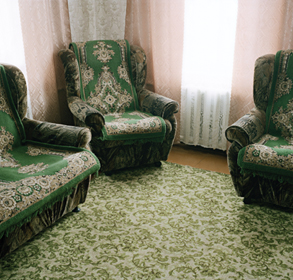Asef Bayat is a privileged observer of two crucial arenas of Muslim politics and society. Iranian by birth and education, he lived through the 1979 Revolution and studied its politics closely. Subsequently he lived and worked in Egypt, and got to know that country intimately. Switching his focus between the two, Bayat provides a powerful contrast between different kinds of Islamic society.
 Bayat sensibly cuts through the banal question of the compatibility of Islam and democracy by pointing out that there is no necessary or intrinsic relation: the key is how different Muslims read their religion in relation to politics. It is only under conditions of modernity and secularisation that some Jews and Christians, and now some Muslims, have come to read democracy into their religions at all. In Muslim milieus these readings are often half-hearted and ambiguous, as is clear from the book’s account, especially of Egypt.
Bayat sensibly cuts through the banal question of the compatibility of Islam and democracy by pointing out that there is no necessary or intrinsic relation: the key is how different Muslims read their religion in relation to politics. It is only under conditions of modernity and secularisation that some Jews and Christians, and now some Muslims, have come to read democracy into their religions at all. In Muslim milieus these readings are often half-hearted and ambiguous, as is clear from the book’s account, especially of Egypt.
In many respects Iran and Eygpt are opposites. The first chapter draws the contrast. Iran: an Islamic Revolution not preceded by an Islamic social movement of any significance, a society which underwent Islamisation from above, then began to reject the repressions and constrictions of Islamic government, and where a reform movement is aiming for democratic institutions, and the separation of religion from the state. Egypt: an Islamic movement of long history which failed to bring about a revolution, though it did penetrate deep into society and culture, an increasingly pious culture with a supposedly “secular” government. Both countries are ruled by repressive regimes, but while Iranians develop innovative social and religious ideas, Egyptians seek solace in reinforced piety and religious discipline.
So, what is the “post-Islamism” of the title? Bayat insists that it is not anti-Islamism, and points out that many of those calling for reform are Muslims, pious even. But it is a curious piety. Surveys in which respondents indicate religious affliliation also indicate that the same people who describe themselves as religious engage in non-marital sex, take alcohol and drugs, and aspire to an American lifestyle.
The paradigm case of post-Islamism is Iran. The initial phase of Islamisation, with its energy and excitement, was ultimately bogged down by contradictions: “Islamists,” Bayat writes, “become aware of their anomalies and inadequacies as they attempt to institutionalise their rule.” Faced with the resistance to religious discipline of many sectors of society, especially women and the young, a new genre of intellectuals attempted to rethink Islam in terms of democracy, human rights and liberty. These trends are at the base of the reformist movement in Iran, which gained limited power in the 1997 elections inaugurating the “Tehran spring”. They failed to hold on to their gains. Yet the movement and its ideas, though under great pressure from the regime of the current President Ahmadinejad, are, Bayat assures us, not finished yet.
In his most brilliant chapter Bayat contrasts this active movement with “Egypt’s passive revolution”. There the political revolution failed, never having a chance in such a tightly policed regime. However, success came through the Islamist penetration of institutions like education and the judiciary, and it’s influence on cultural policy. The regime is ever vigilant against challenges to its control. It ruthlessly suppressed the Islamic radicals and is now engaged in repressing the peaceful Islamist challenges. At the same time it has incorporated religious themes and personnel into itself and used them as means of legitimacy and control.
Bayat presents a vivid picture of the different modes of religiosity in Egyptian society: the rich women who follow fashionable Muslim “televangelists” and observe the minutiae of ritual; the angry young of the lower-middle classes, educated but poor; the intelligentsia which has merged xenophobic nationalism with Islamism.
Unlike in Iran there is a stagnation of intellectual life, including Islamic scholarship, which mainly consists of a repetition of the debates of the 19th century. This Islamism only becomes political in relation to external enemies: America and Israel but also a mythical hostile “West”.
Bayat, having painted this grim picture, attempts a bit of optimism, noting recent challenges to the regime in terms of democracy and human rights. But these, while encouraging, don’t seem to be having much effect. It is not, in the end, Islam itself, but the distinct structures of power and authority which continue to make democracy seem a remote prospect in these great but troubled countries.
Making Islam Democratic is published by Stanford University Press

